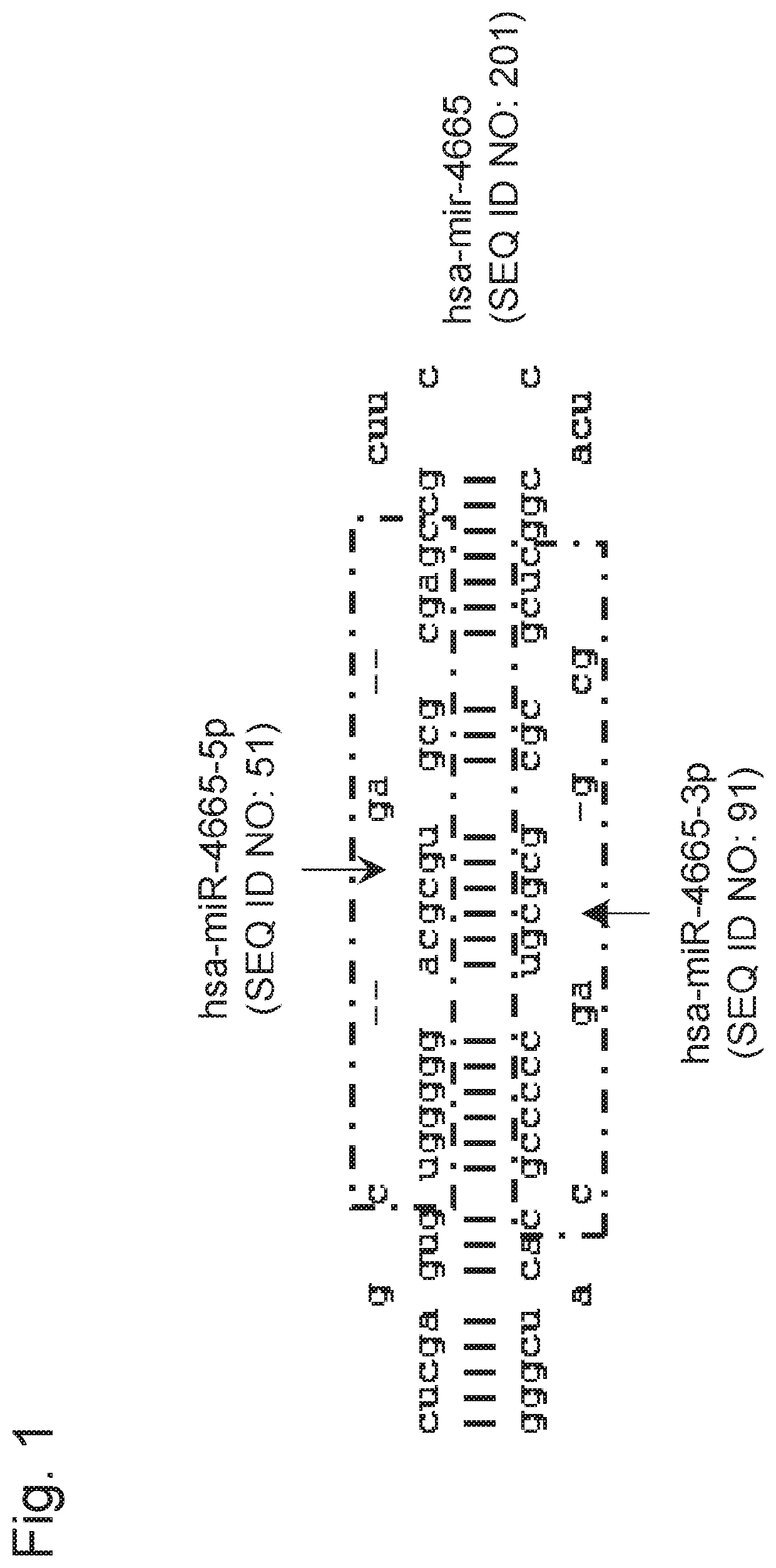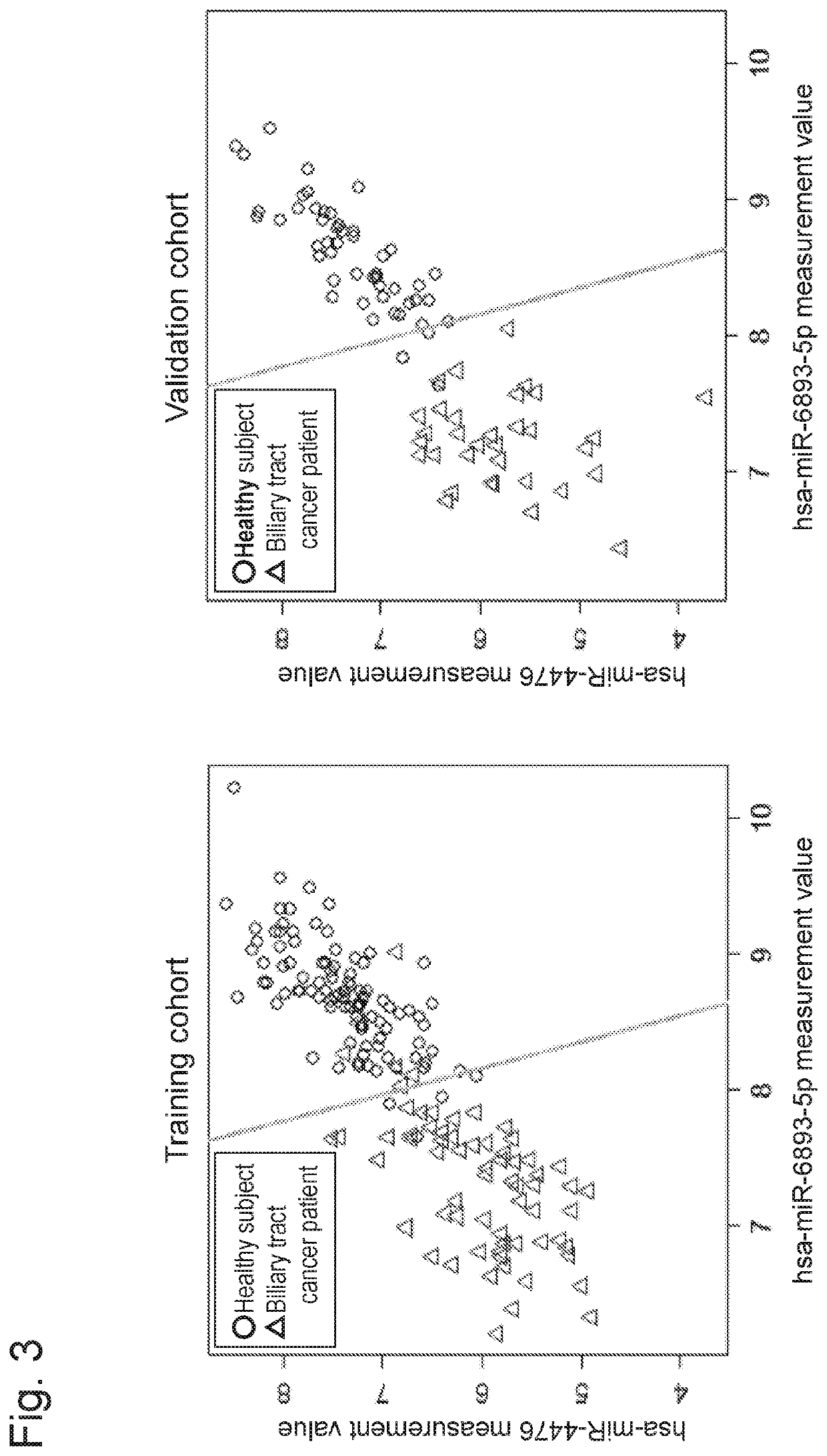Biliary tract cancer detection kit or device, and detection method
a bile duct cancer and kit technology, applied in the field of biliary tract cancer detection kits or devices, can solve the problems of poor prognosis, difficult operation of bile duct cancer that develops closer to the liver, and lack of subjective symptoms of early biliary tract cancer, so as to reduce the burden on patients, reduce the rate of recurrence, and high sensitivity
- Summary
- Abstract
- Description
- Claims
- Application Information
AI Technical Summary
Benefits of technology
Problems solved by technology
Method used
Image
Examples
reference example 1
[0562]
[0563]Sera were collected using VENOJECT II vacuum blood collecting tube VP-AS109K60 (Terumo Corp.) from 100 healthy subjects and 67 biliary tract cancer patients (1 case with stage IA, 8 cases with stage IB, 8 cases with stage II, 3 cases with stage IIA, 5 cases with stage IIB, 14 cases with stage III, 2 cases with stage IIIB, 1 case with stage IVa, and 25 cases with stage IVb) confirmed to have no primary cancer in organs other than the biliary tract after acquisition of informed consent, and used as a training cohort. Likewise, sera were collected using VENOJECT II vacuum blood collecting tube VP-AS109K60 (Terumo Corp.) from 50 healthy subjects and 33 biliary tract cancer patients (1 case with stage 0, 2 cases with stage I, 1 case with stage IA, 2 cases with stage IB, 2 cases with stage II, 5 cases with stage IIA, 4 cases with stage IIB, 5 cases with stage III, 1 case with stage IV, 1 case with stage IVa, and 9 cases with stage IVb) confirmed to have no primary cancer in or...
reference example 2
[0568]
[0569]Sera were collected using VENOJECT II vacuum blood collecting tube VP-AS109K60 (Terumo Corp.) from each of 35 colorectal cancer patients, 37 stomach cancer patients, 32 esophageal cancer patients, 38 liver cancer patients, and 13 benign pancreaticobiliary disease patients confirmed to have no cancer in other organs after acquisition of informed consent, and used as a training cohort together with the samples of 67 biliary tract cancer patients (1 case with stage 0, 2 cases with stage I, 1 case with stage IA, 4 cases with stage IB, 8 cases with stage II, 4 cases with stage IIA, 6 cases with stage IIB, 14 cases with stage III, 1 case with stage IIIB, 25 cases with stage IV, and 1 case with stage IVa) and 93 healthy subjects of Reference Example 1. Likewise, sera were collected using VENOJECT II vacuum blood collecting tube VP-AS109K60 (Terumo Corp.) from each of 15 colorectal cancer patients, 13 stomach cancer patients, 18 esophageal cancer patients, 12 liver cancer patien...
example 1
[0570]
[0571]In this Example, a gene marker for discriminating a biliary tract cancer patient from a healthy subject was selected from the training cohort, and a method for evaluating biliary tract cancer discriminant performance of each selected gene marker alone was studied in samples of the validation cohort independent from the training cohort.
[0572]Specifically, first, the miRNA expression levels of the training cohort and the validation cohort obtained in Reference Example 1 above were combined and normalized by quantile normalization.
[0573]Next, genes for diagnosis were selected using the training cohort. Here, in order to acquire diagnostic markers with higher reliability, only genes having the gene expression level of 26 or higher in 50% or more of the samples in either of the biliary tract cancer patient group in the training cohort or the healthy subject group in the training cohort were selected. In order to further acquire statistically significant genes for discriminati...
PUM
| Property | Measurement | Unit |
|---|---|---|
| Northern blot | aaaaa | aaaaa |
| concentration | aaaaa | aaaaa |
| threshold | aaaaa | aaaaa |
Abstract
Description
Claims
Application Information
 Login to View More
Login to View More - R&D
- Intellectual Property
- Life Sciences
- Materials
- Tech Scout
- Unparalleled Data Quality
- Higher Quality Content
- 60% Fewer Hallucinations
Browse by: Latest US Patents, China's latest patents, Technical Efficacy Thesaurus, Application Domain, Technology Topic, Popular Technical Reports.
© 2025 PatSnap. All rights reserved.Legal|Privacy policy|Modern Slavery Act Transparency Statement|Sitemap|About US| Contact US: help@patsnap.com



